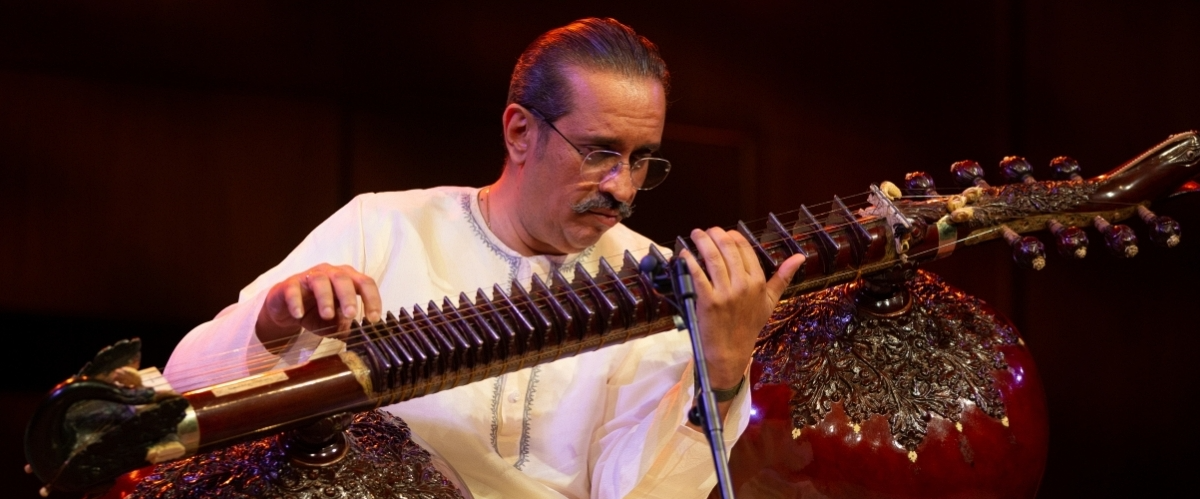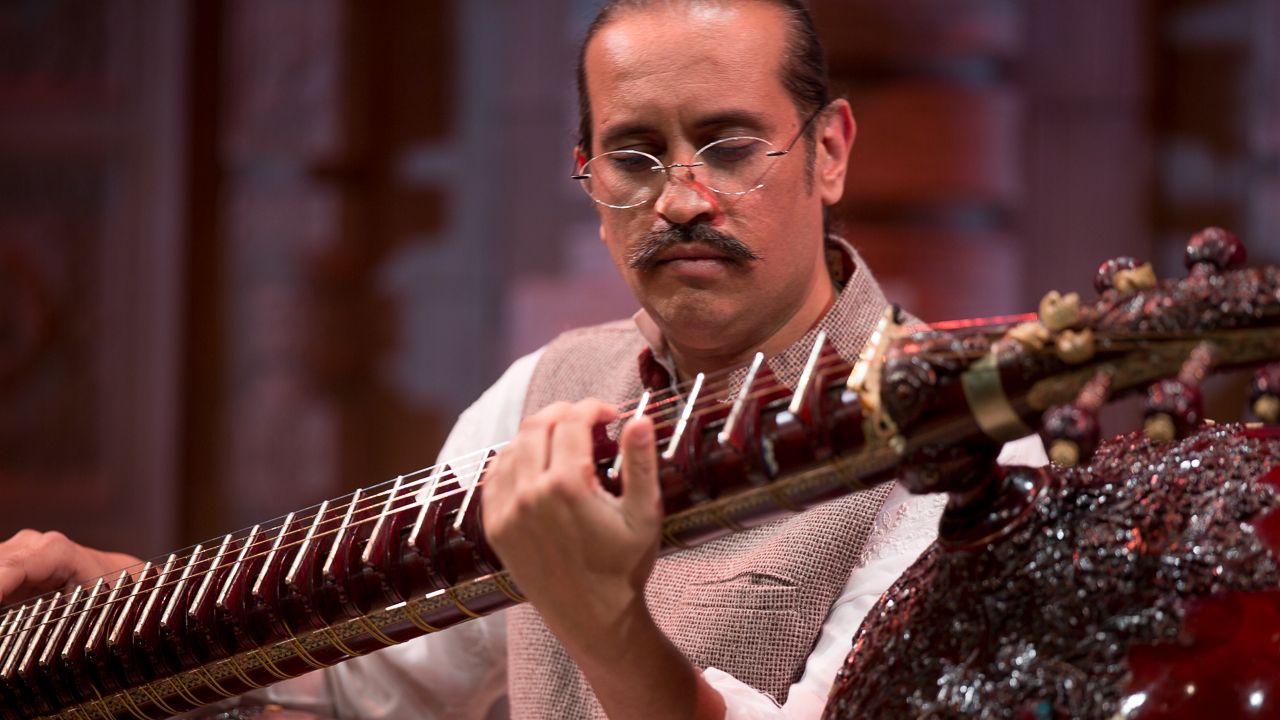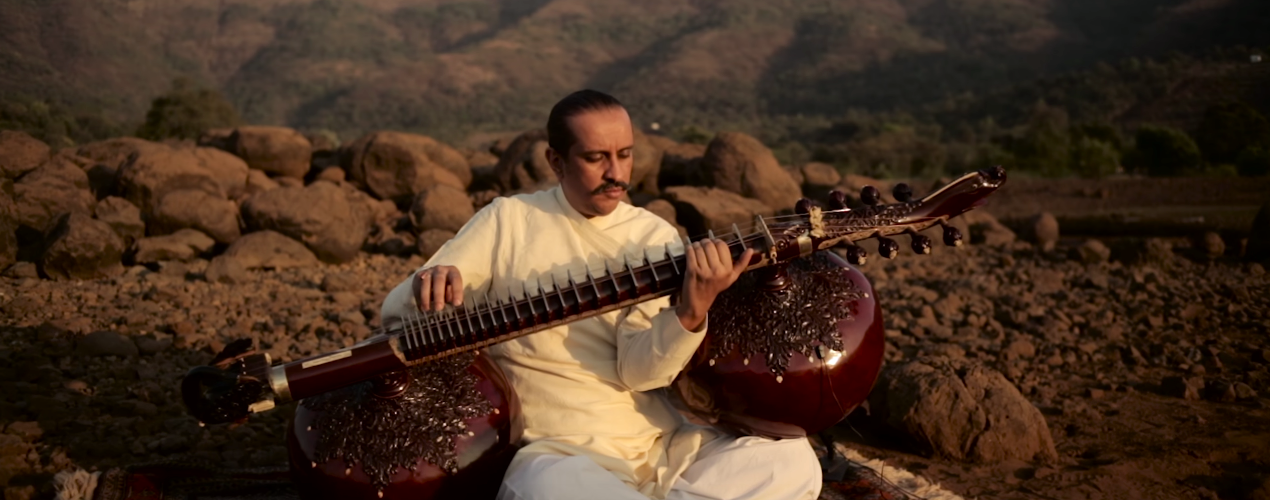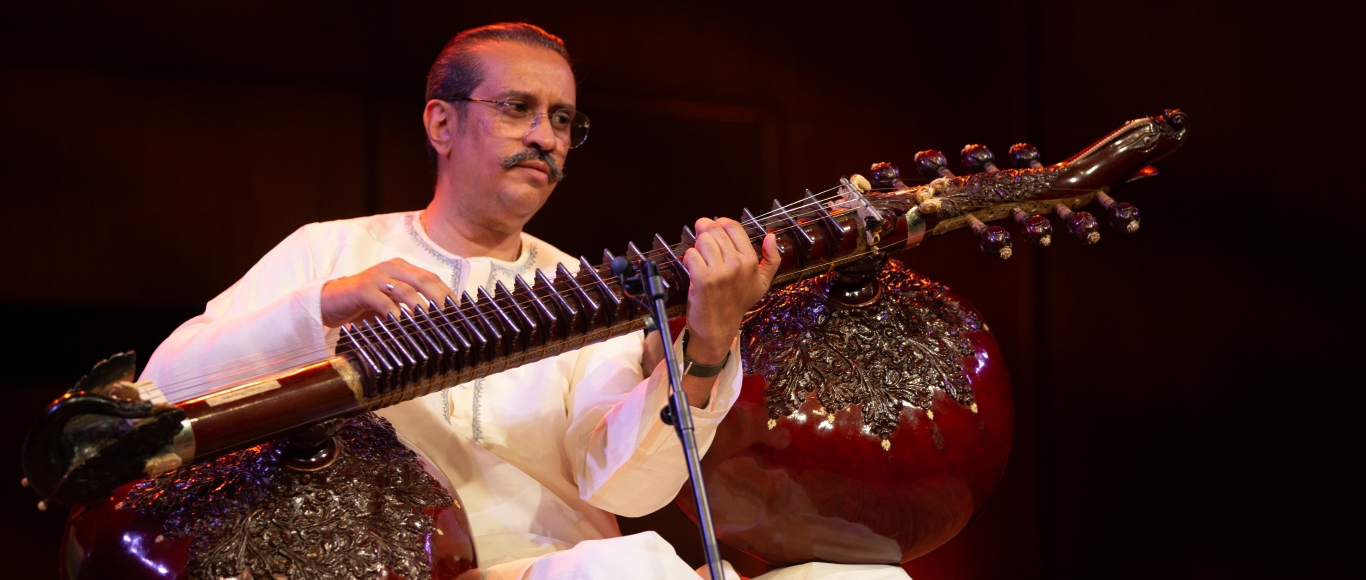

The rudra veena maestro discusses Dhrupad's curious modern context following his landmark solo performance at the Purcell Room.
—Part of Living Traditions: 21 articles for 21st-century Indian classical music
Indian classical music has long been a global phenomenon, and it is no surprise when virtuosic sitar-tabla duets sell out large London auditoriums. But for a three-hour unaccompanied rudra veena recital to do the same is remarkable. Ustad Bahauddin Dagar brought the instruments low, austere tones to a full house at London's Purcell Room in March 2019, superbly presenting undiluted Dhrupad in a one-off concert organised by Darbar.
Some trace the Dagarvani lineage right back to Nayak Haridas, a 16th-century court musician said to have taught Tansen himself, the legendary musician-composer of Emperor Akbar's court. Bahauddin represents the 20th generation, and first studied under his father Ustad Zia Mohiuddin, a revered figure in modern veena history.
In London he took the rare step of foregoing pakhawaj (double-headed drum) accompaniment, relying on nothing but his own seven strings to fill the room. Before playing he invited the audience to see the ragas like miniature paintings, where the focal point is not in the picture itself, but in you.
His veena's measured textures left nothing hidden from the listener, opening with a long alap (rhythmless improvisation) in the rain-bringing Raag Miyan ki Malhar. Within seconds I was reminded just how much is lost to technology on even the finest recordings - few albums even half-capture the fluid shapeshifting of the veena's deep-toned bends, which swell upwards and unfurl in precise ripples. He often settled far into mandra saptak (lower octave), looping up sparse melodies and gently recolouring them through the jor and jhalla (steadily pulsed sections).
Miyan ki Malhar's final phrase was still resonating when Bahauddin embarked on the next raga, Bihag, barely even looking up to acknowledge the transition. Though perhaps confusing to some, I was taken aback by how natural the lack of silence seemed - as if his immediate resumption hinted at some grand natural rotation through Dhrupad's traditional alap-jor-jhalla structure that could hardly be interrupted for the sake of an audiences desire to applaud. Whatever the purpose, few in the room wished to break focus.
Bihag's vadi (king note) is shuddha Ga (natural 3rd), a swara not present in the preceding Malhar's wide pentatonic ascent. Bahauddin employed it judiciously, gradually filling the space with ever-expanding articulations and weaving silken threads in their wake. The relief brought by Ga s introduction was palpable, but melodies still retained an introspective essence, pausing in slow-motion stutter to temper any sustained release of tension.
The evening concluded with a half-hour version of Raag Kaunsi Kanada. Khayal-infused renditions tend to imbue the raga with a sharp passion and longing, but Dhrupad always retains its restraint. Even the Ustads faster passages felt unclustered - his technique, though formidable, never seems to cloud his aesthetic sensibilities (listen in the video above). He has been known to approvingly quote the words of a fellow beenkar: 'We cannot compromise with the instruments rituals even if we die of hunger'. The word 'dhrupad', after all, translates from Sanskrit as 'permanent verse' or 'immovable pillar'.

The veena's 7 strings are set against 24 knife-like frets. Photo: Jagdeep Shah.
It is heartening to watch a 20th-generation Dhrupad master walk off a prestigious London stage as hundreds stand to applaud, and tempting to take such an occurrence as proof that the music must be in good health. But the fuller picture is far more complex. Dhrupad does now have a global following, but its practitioners often struggle to find space on concert platforms back home.
The music's traditional economic foundation was removed suddenly with Indian Independence, as political reorganisation largely dismantled the system of princely courts. Bahauddin's father and uncle struggled to find a place in the world after leaving their Udaipur hometown, and some of the family ended up making bread and working in garages to survive. But they refused to dilute their style, keeping the music alive in private.
Eventually they found devoted audiences again. But unexpectedly, much the resurgence came in Europe, where the influential musicologist and Hindu convert Alain Daniélou introduced Ustads Moinuddin and Aminuddin Dagar (the 'senior' Dagar brothers) to Europe as part of a UNESCO program in the 1960s. They were met with instant adulation, returning regularly and making some of the genre's landmark recordings in Paris. France's Dhrupad Society has been going strong since the 1980s, attracting serious students as well as listeners.
The advent of classical minimalism further piqued Western curiosity. Pioneers including Terry Riley and La Monte Young were drawn to Dhrupad's characteristically non-linear, 'outside of time' feeling, and both studied its slow textural elaborations in detail. The Dagars found a warm welcome in North America, and their sounds now have a firm footing there thanks to organisations such as the Seattle-based Dhrupad Music Institute of America. And another more recent global resurgence is underway thanks to the internet, as open-eared young Millennials seek solace and relief from a fast-paced modern world.
Meanwhile, audiences back in India have steadily dwindled, with material support proving hard to come by for such decidedly irreducible, non-commercial music. The resulting geographical disbalance led the late vocalist Ustad Sayeeduddin Dagar, Bahauddin's great-uncle, to quip that "one day Dhrupad will be imported to India".

'We cannot compromise with the instruments rituals even if we die of hunger'. Photo: Sandeep Virdee
Two days after the performance I met with Bahauddin, and we discussed the musics curious modern context over a somewhat jarring backdrop of coffee-house Sinatra. "You couldn't find a concert like that in India, with three hours of solo rudra veena. Producers there wont take the risks. At the end of her life [Hindustani vocal pioneer] Kishori Amonkar said she wanted to do a concert with no tabla, but even then none of the organisers would let her."
But how did this situation come about? Surely cities such as Benares have enough Dhrupad devotees to fill several auditoriums? "The sponsors have a very big say. They want particular artists, and can even request particular renditions. The organisers may be obliged to try and make this happen."
He acknowledges other challenges faced by modern beenkars: "Today only a few craftsmen can produce instruments of high quality. Expertise is evaporating, and being lost to things with more money. The veena is difficult to make, requiring two identically-sized gourds of at least five feet in diameter with the same thickness and sound qualities. All parts must connect in a very particular manner. But a good quality veena can last for more than a century."
It is clear that he is motivated by a direct connection with the music, with little desire to uphold old custom for its own sake. "When it comes to performance I still don't feel so much responsibility to the tradition itself. But I know I should be producing meaningful musicians to carry on the work in future generations. In India I have five dedicated students - those who are willing to leave everything and learn with me for eight years. But the veena is not easy. You cannot play small things. You have to start with alap , and the required skills take time."
The instrument is most at home in sacred settings. The name translates to roaring veena, suggesting an incarnation of Lord Shiva, and it has traditionally been used to accompany Vedic yajna (fire rituals) and mantra-pathan (prayer recitals). Many of its devotees pursue ascetic lives in search of self-knowledge - 20th-century master D.R. 'Veena Baaba' Parvatikar lived as a monk in the Himalayas, playing at the Badrinath Temple and eventually gaining recognition as a Hindu saint. In Bahauddins words, "learning is not just the technique. It has to be a way of life".
I mention that several of todays most promising young exponents hail from outside India. Carsten Wicke is German, Heikel Ben Mlouka is French-Tunisian, and Bahauddin is currently staying with a British learner. The veena has thus far been inseparable from Indias devotional traditions, so might its new global context reshape the sound? "For every instrument there is a pace of life - sitar, sarod, veena, etc. A beenkar must never be in a hurry. But in the West it is very hard to be relaxed, and not get bothered about things. You have to change your entire outlook."
In other words, the musician must adapt to the requirements of the music rather than the other way round. "Who you are is what you're playing. Your identity comes through what you create, and I want to retain the identity of my tradition. I believe in its strength - if we can gather musicians who are sensitive and work hard then the music will look after itself."

'A beenkar must never be in a hurry'. Photo: Jagdeep Shah.
But even the most abstract, meditational music does not exist in a vacuum, and the dedication of musicians alone guarantees little in the way of stability. What else is needed?
I asked Sandeep Virdee, Darbar's Artistic Director (and my boss), who organised the concert: "You must treat the audience with respect, and not think they are only ready absorb this or that. If you believe in the music then you must believe it can find an appreciative audience. We never take direction from sponsors at our festivals".
"Technology is important too. This music deserves superb microphones, and we use the internet to reach new audiences, with a thriving YouTube channel and full performances on the Darbar Player site. People around the world can find high-quality Dhrupad this way as well as other styles. Indian classical artists must be able to play the music of their choosing, and we must work to bring it to new ears".
Bahauddin also credits modern technology with helping to revitalise the music. "Dhrupad has a stable audience now. YouTube has helped it grow, and people are listening to a lot of recordings - my father, my uncle, and other gharanas too. The sound of the veena will also improve along with the technology. I am working with some craftsmen now, with new ideas for the woodwork and construction. And with each new student the demand grows."
Jyoti Hegde has in recent years emerged as the first full-time female artist, and greater social inclusivity can only help to increase demand further (for both veenas and female exponents of them). But challenges of scale are still significant, and the veena has only a handful of living masters - Bahauddin jokes that "there are no elders left to criticise the nonsense we play".
There are benefits to Dhrupad's decidedly niche status too. Those who devote themselves to it are only ever there for the sake of the music, which has itself absorbed few outside influences, protected by its highly particular nature. A sitarists classical playing can be affected by frequent forays into fusion, but Dhrupad's slow, architectural world does not exactly lend itself to filmi or keyboard jams.
This is not to say that innovation has been absent - for example, artists have in recent decades augmented the Dagarvani's predominantly Islamic repertoire with Hindu poetry. But the tradition has largely innovated from within itself, retaining a certain purity along the way. It may be India's oldest surviving form of classical music, but Dhrupadyas consider it to be the most highly evolved by virtue of this. Learning its fine-lens landscape of sruti (microtones) takes years - Bahauddin employs seven distinct shades of Sa (root note), tuned in correspondence with the suns daily arc.
Seemingly inclined think in terms of these grand natural rotations, he looks to the long-term when I ask him about Dhrupad's future. "I feel like we are like one point on a great bicycle wheel. Sometimes we will be down, other times up. We went down after Independence, as stable employment in the princely court was removed from the musicians, but in the 1960s my family found new audiences in the West. There was a decline in the 1990s as many of our great musicians died, but with the internet we are moving up again. It is beautiful that an event like this can sell out in London, and maybe in 100 years we will be really strong".
• George Howlett is a London-based musician and writer, specialising in jazz, rhythm, Indian classical, and global improvised music.
Darbar believes in the power of Indian classical music to stir, thrill, and inspire. Explore our YouTube channel, or subscribe to the Darbar Concert Hall to watch extended festival performances, talk and documentaries in pristine HD and UHD quality.
The Jaipur-Atrauli vocalist talks ragas from the past, rhythms as warrior-heroes, and the limits of approaching music...
Read More 
The Hindustani slide guitar pioneer discusses instrument creation and the hidden harmony in ragas. By George Howlett...
Read More 
Ustad Abdullah Khan is the last shehnai player to play the composition of Ustad Bismillah Khan in Pakistan. Following...
Read More 
The beginner's guide to Indian classical music. Whether you’re completely new to raga music or just need a refresher, we’ve put together this brief overview of all things raga music to help you feel at ease when visiting one of our concerts or watch our videos on our YouTube or our Darbar Concert Hall.
Keep up to date with the latest news, events, music and musings across our social channels
For hundreds more clips and shorts, vist our YT page here 